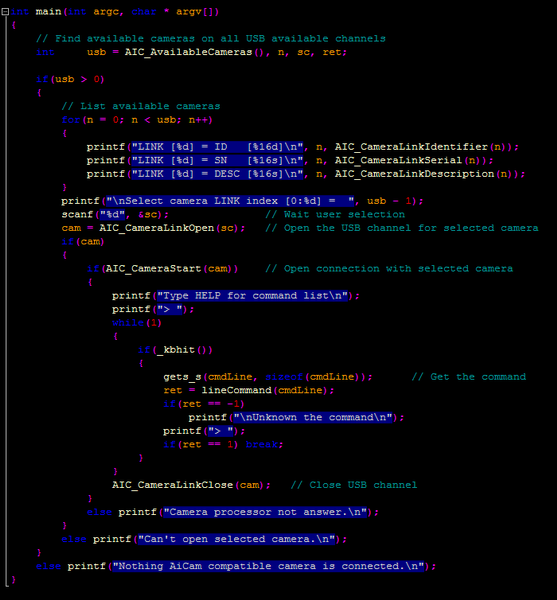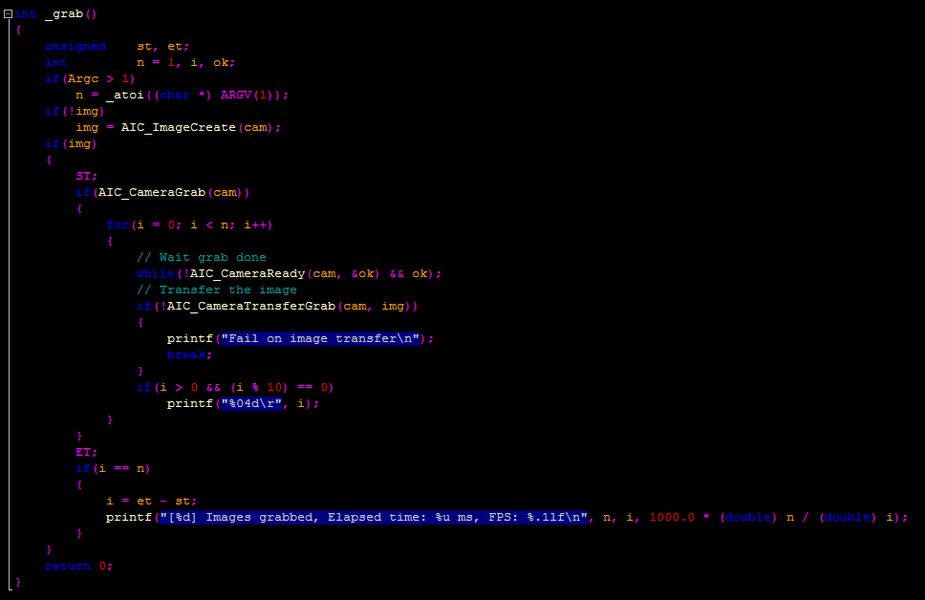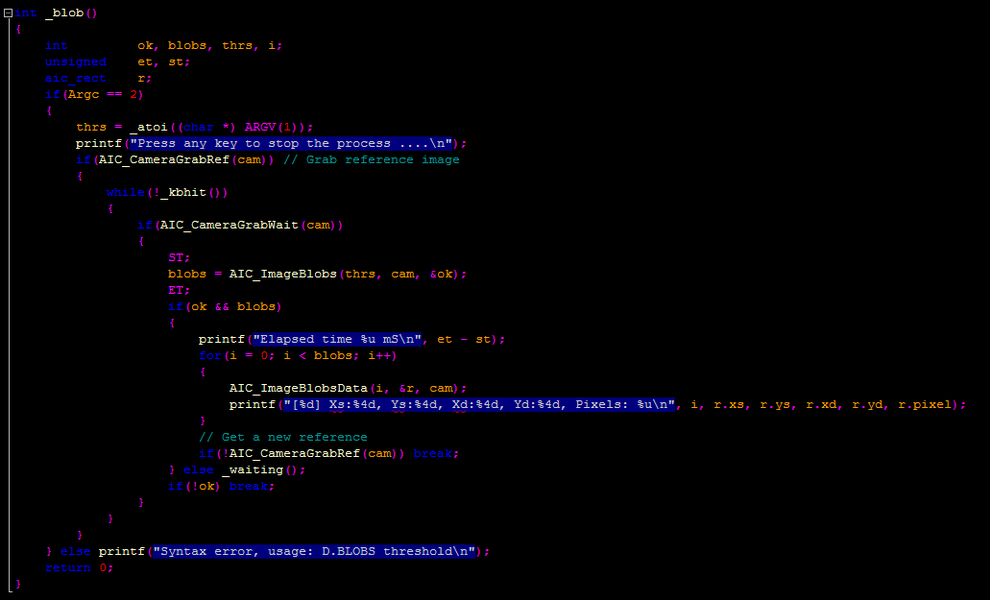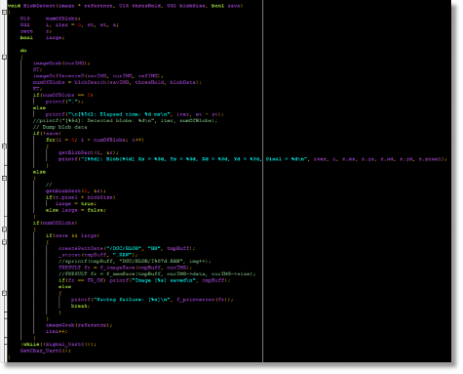xCAM - Digital's Sight Perception and measure system platform
Attenzione questo progetto non é piú attivo! Questa pagina viene mantenuta come riferimento di informazione per i numerosi utilizzatori.
Per assistenza e ricambi non esitate a contattarci abbiamo ancora diverse unitá e parti.
UNA VALIDA ALTERNATIVA A QUESTO PRODOTTO É CORE-CAM
Attention this project is no longer active! This page is maintained as an information reference for the numerous users.
For assistance and spare parts please contact us we still have different units and parts.
AN ALTERNATIVE VALID FOR THIS PRODUCT IS CORE-CAM
xCAM implementa un sistema di percezione visiva digitale.
Una piattaforma che integra un sensore di visione ed un sistema di elaborazione digitale in grado di offrire una misura in uscita, come un comune sensore industriale, utilizzando come ingresso le immagini riprese.
xCAM implements a Digital Sight Perception and measure system.
A platform that integrates a image sensor and a digital processing system that can provide an output measurement, such as a common industrial sensor, using grabbed images as input.
VANTAGGI
- Effettua elaborazioni delle immagini riprese di tipo basilare ed avanzato
- Le misure da effettuare si realizzano con estrema semplicitá
- Ha una grande memoria interna per il salvataggio delle misure
- Ha una grande flessibilitá di funzionamento grazie alle molte opzioni disponibili e ad un hardware modulare
- Si collega ad un sistema remoto con una grande varietá di interfacce: seriale, WiFi, USB
- Ha consumi molto ridotti (0.5W) tanto da poter essere alimentata a batteria
- É un sistema realmente in grado di operare da solo e permette di interagire con l'utente tramite una interfaccia grafica.
ADVANTAGES
- Makes basic and advanced image processing
- The measures to be taken are achieved with extreme simplicity
- It has a large internal memory for saving the measurements
- It has great operational flexibility thanks to the many options available and a modular hardware
- It connects to a remote system with a wide variety of interfaces: serial, WiFi, USB
- It consumes very small (0.5W) so that it can be powered by battery
- It is really a system that can operate standalone, with user friendly graphic display.
CARATTERISTICHE
Lo sviluppo di questa piattaforma ha tenuto come prioritá quello di realizzare un "sensore" in grado di produrre misure veloci e precise.
Tutte le scelte fatte sono centrate su questo punto inoltre si é realizzato un sistema espandibile per conferirgli la massima adattabilitá alla risoluzione dei problemi richiesti.
FEATURES
The development of this platform has given priority to the creation of a "sensor" capable of producing fast and precise measurements.
All the choices made are centered on this point, and an expandable system has been developed to give it maximum adaptability to the problem solving required.
SENSORE DI IMMAGINE
Per la ripresa dell’immagine si è utilizzato un sensore CMOS con le seguenti caratteristiche:
- Ridotto numero di pixel (752x480) per diminuire il tempo di elaborazione.
- Pixel di grosse dimensioni (6x6um) per una buona sensibilitá anche a bassa illuminazione.
- Efficienza quantica > 40% nel visibile ma ancora valida nel NIR fino a 1100nm.
- Otturatore globale per non avere artefatti nell’immagine ripresa.
- Elevata velocitá di otturazione per riprendere eventi veloci (<2us).
- Buon range dinamico dell’immagine (12 bit in compansione).
- Capacitá di eseguire binning 1x1, 2x2, 4x4 per ridurre il tempo di lettura ed aumentare la sensibilitá.
- Cattura parziale dell’immagine (Region Of Interest) per ridurre il tempo di lettura ed il consumo di memoria.
- Velocitá di lettura dell’immagine 25 quadri al secondo in piena risoluzione.
- Per speciali misure multispettrali ed in genere correlate all’informazione cromatica si puó utilizzare questo sensore con maschera di Bayer.
- Attacco per obiettivo tipo C, CS o M12.
IMAGE SENSOR
For the image capture, a CMOS sensor has been used with the following features:
- Reduced number of pixels (752x480) to lessen processing time.
- Large size pixels (6x6um) for good sensitivity even at low illumination.
- Quantum efficiency> 40% in visible but still valid in NIR up to 1100nm.
- Global shutter to prevent artifacts in grabbed image.
- High speed shutter to grab fast events (<2us).
- High dynamic image range (12 bit companded).
- Capability to perform binning 1x1, 2x2, 4x4, to increase sensitivity and to reduce readout time.
- Region Of Interest (image) capability to reduce readout time and memory consumption.
- Frame rate 25 frames per second in full resolution.
- For special multispectral measurements and generally related to color information, you can choose a sensor with Bayer filter.
- Attachment for lens type C, CS or M12.
ELABORAZIONE DIGITALE E MODULI DI ESPANSIONE
Per il trattamento delle immagini e per tutto ció che concerne l'ingresso uscita si é impiegato il modulo CORE-2 che integrato sul restante hardware realizza le seguenti caratteristiche:
- Processore BF514/8 (CORE-2), con clock di 400MHz (overclock fino a 600MHz)
- 64 MB di memoria SDRAM (133MHz) per la memorizzazione temporanea delle immagini e per il codice.
- 8 GB di memoria NAND per la memorizzazione dei dati elaborati (opzionale).
- Interfaccia SD (Secure Digital fino a 32GB) a 4bit compatibile FAT32 e capace di salvare dati in questo formato ad una velocitá media di 5MB/s.
- RTC, orologio calendario (richiede batteria esterna).
- Interfaccia WiFi (M2 - opzionale).
- Interfaccia SPI (Y8) veloce per interfacciamento con moduli esterni come:
- Moduli di camere con sensori CMOS a colori ad alta risoluzione.
- Moduli con sensori IR (10um).
- Interfacce su bus ESPI
- Due interfacce seriali (Y7-LVTTL)
- Interfaccia multifunzione ad 8 bit (Y5), ogni singolo bit puó essere:
- Ingresso A/D 12bit 0-2.5V.
- Uscita D/A 12 bit 0-2.5V.
- Uscita digitale LVTTL.
- Ingresso digitale LVTTL.
- Interfaccia multifunzione UENG-S2 (opzionale) posta sul bus a 16bit (M1) del processore offre le seguenti funzioni:
- Interfaccia USB 2 con 40MB/s di banda.
- DC-DC per alimentazione da batteria LiION (3.7V) con ricarica da USB.
- Interfaccia per encoder rotativo per selezione funzioni.
- Ingresso trigger per risveglio da standby, ad esempio tramite un PIR od un interruttore.
- Interfaccia multifunzione xCAM-AUX (opzionale) posta su connettore (Y4) di espansione che include le seguenti funzioni:
- Ingresso/uscita per controllo display TFT e relativo schermo tattile.
- Sensore IMU a 9 assi.
- Controllo di due motori in DC per controllo fuoco e zoom (obiettivi motorizzati).
- Controllo per alimentazione LED di potenza (illuminatore).
- DC-DC per alimentazione da 9 a 20VDC
DIGITAL PROCESSING AND EXPANSION MODULES
This module, integrated in the remaining hardware, has the following features:
- Processor BF514/8 (CORE-2), with 400MHz clock (overclock up to 600MHz)
- 64 MB of SDRAM (133MHz) memory for temporary storage of images and code.
- 8 GB of NAND memory to save processed data (optional).
- SD (Secure Digital Up to 32GB) with 4bit interface, FAT32 compatible and capable of saving data in this format at an average speed of 5MB/s.
- RTC, calendar clock (requires external battery).
- WiFi interface (M2 - optional).
- SPI (Y8) interface to connect external modules such as:
- High resolution color CMOS sensor modules.
- IR sensors (10um) Modules .
- ESPI bus interfaces.
- Two serial interfaces (Y7-LVTTL).
- 8 bit multi-function interface (Y5), each single bit can be:
- A/D input 12bit 0-2.5V.
- D/A output 12 bit 0-2.5V.
- LVTTL digital output.
- LVTTL digital input.
- UENG-S2 Multifunction Interface (optional) connected on the 16-bit bus processor (M1), includes the following features:
- USB 2 interface with 40MB/s bandwidth.
- DC-DC for battery powered LiION (3.7V) with USB charging.
- Rotary encoder interface for functions selection.
- Trigger input for stand-by awakening, for example via a PIR or a switch.
- xCAM-AUX Multifunction interface (optional) connected to expansion connector (Y4) includes the following features:
- Input/Output for TFT display control and related touch screen.
- 9-axis IMU sensor.
- Control of two DC motors for focus and zoom control (motorized lenses).
- Power LED (illuminator) controls.
- DC-DC to extend the power input in the range 9-20VDC.
MODALITÁ DI PROGRAMMAZIONE E CONFIGURAZIONE
xCAM si programma in modi molto differenti con una complessitá ad aumentare, le prime due possibilitá si basano sul semplice sistema operativo xCOS disponibile come base di partenza, mentre la terza offre la massima libertá ed efficienza:
- Modalitá batch, si scrivono una serie di comandi (facenti parte di xCOS) con relativi parametri in un file (autoexec.sh) che viene salvato in SD. All’accensione se il processore trova questo file lo mette in esecuzione.
- Si utilizza BC, è un semplice linguaggio di programmazione molto simile al basic che permette di aumentare molto il livello di complessitá richiesto pur mantenendo un ottima velocitá di esecuzione perché compilato in un byte-code. Per metterlo in esecuzione basta impostare il relativo comando in un file batch come sopra.
- Si utilizza il linguaggio C all’interno del sistema di sviluppo libero (BFTC) completo di una vasta gamma di librerie e controlli di basso livello.
PROGRAMMING AND CONFIGURATION MODE
xCAM can be programmed in a very different ways with a complexity to increase, the first two possibilities are based on the simple xCOS operating system available as base application, while the third offers maximum freedom and efficiency:
- Batch Mode, you write a set of commands (part of xCOS), with its parameters, in a file (autoexec.sh) that is saved in SD. If the processor find this file at the boot time, open it and run each listed commands.
- BC, is a simple programming language very similar to the basic that allows to greatly increase the level of complexity required while maintaining a good execution speed because it is compiled in a byte-code. To run it, just set its command in a batch file as above.
- C language can be used with it's proper free development system (BFTC), complete with a wide range of low-level libraries and controls.
SPECIFICHE
SPECIFICATIONS
| Core | BF514F16 or BF518F16 @ 400MHz |
| RAM Embedded | 116 Kbyte @ 400MHz |
| SDRAM | 64MB, 16bit @ 133MHz |
| FLASH Embedded | 2MB |
| FLASH NAND | 8GB (optional) |
| EEPROM | 128 KB |
| Secure Digital | 4 bit in DMA, FAT32 compatible capable with format of an average speed of 5MB/s |
| Real Time Clock | Require an 3V external battery |
| Multifunction Port | 8 channel, each configurable as 12 bit A/D, 12 bit D/A or bidirectional parallel port |
| Illuminator port | Dedicated connector for LED illuminator controls, 4 bit (LVTTL) |
| Serial Port | 2 x asynchronous high speed serial ports (LVTTL) |
| SPI Port | High speed (100MHz) synchronous serial port, 3 bit (MISO, MOSI, SCLK) plus 3 device select (LVTTL) |
| WiFi | 2.4 GHz IEEE Std. 802.11 b/g with optional module M2 |
| USB 2 | Full Bandwidth (40 Mbyte/s), with optional expansion module USB-ENGINE-S2 |
| I/O Expansion Connector | With additional SPI, I2C, Parallel ports (LVTTL) |
| Bus Expansion Connector | 16bit 133MHz microprocessor bus (LVTTL) |
| Power Supply | 5VDC ±5% 100mA without any optional expansion module |
| Power Supply by Battery | LiION 3.7V with expansion module USB-ENGINE-S2 |
| Power Supply Wide Input | 9V to 20VDC with expansion module xCAM-AUX |
| Board Size | 65 x 55mm |
| Operating temperature | –30°C to +70°C |
| Sturtup time | 50ms |
| Optical format | 1/3-inch |
| Resolution | 752x488 |
| Pixel size | 6x6 um |
| Active Imager Size | 4.51(H) x 2.88 (V) 5.35mm diagonal |
| Filter array | Monochrome or RGB Bayer |
| Digitizing | 10 bit in linear mode, 12 bit in companded mode |
| Shutter Type | Global |
| Shutter efficiency | >99% |
| Frame Rate | 25 fps @ Full Resolution |
| Dynamic Range | >55dB linear; >80dB-100dB in HDR mode |
| Responsivity | 4.8V/lux-sec (550nm) |
| Binning | 1x1, 2x2, 4x4 |
| Auto Exposure Control | Under software controls |
| Auto Gain Control | Under software controls |
| Thread | M12, CS, C |
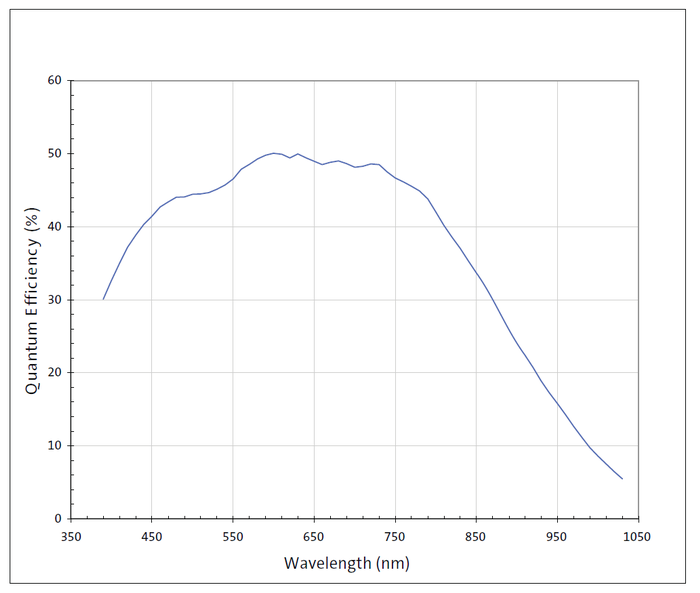 | ||
CONTROLLO REMOTO DA USB
Con il modulo di espansione xCAM-AUX inserito é possibile utilizzare xCAM come una normale camera digitale, accedere ad i settaggi interni o utilizzare le proprie funzioni di analisi e processo.
Per questo scopo é disponibile una libreria (DLL) per C/C++, ma anche per programmi terzi in grado di aprire DLL (_stdcall).
Con il modulo di espansione xCAM-AUX inserito é possibile utilizzare xCAM come una normale camera digitale, accedere ad i settaggi interni o utilizzare le proprie funzioni di analisi e processo.
Per questo scopo é disponibile una libreria (DLL) per C/C++, ma anche per programmi terzi in grado di aprire DLL (_stdcall).
Se si vuole utilizzare questa libreria occorre come prima operazione installare i driver per il proprio sistema operativo, poi occorrono i seguenti files:
aicamdef.h // Definizioni
aicam.h // Prototipi delle funzioni
aicam.dll // Libreria dinamica
aicamdef.h // Definizioni
aicam.h // Prototipi delle funzioni
aicam.dll // Libreria dinamica
aicam.lib // Libreria per collegamento esplicito
Se si desidera visualizzare le immagini occorrono alcune librerie OpenCV3 che trovate nel pacchetto di esempio.
Qui sotto si riportano alcuni scorci di codice:
REMOTE CONTROL FROM USB
With the xCAM-AUX expansion module inserted, you can use xCAM as a standard digital camera, access internal settings, or use its analytics and process functions.
For this purpose a library (DLL) for C/C++ is available, but also can be used by third-party programs that can open DLLs (_stdcall).
If you want to use this library you should first install the drivers for your operating system, then the following files are needed:
aicamdef.h // Definitions
aicam.h // Function prototypes
aicam.dll // Dynamic Library
aicam.lib // Library for explicit link
If you want to see the images you need some OpenCV3 libraries that you find in the sample package.
Below you will find some segments of code:
CONTROLLO REMOTO DA SERIALE
Utilizzando il cavetto di programmazione XC-LVT-U2 é possibile riprogrammare il codice in flash di xCAM o poterci dialogare, tramite una emulazione terminale, utilizzando i comandi disponibili su xCOS, qui uno scorcio del comando HELP.
Per maggiori dettagli sui comandi disponibili si rimanda alla pagina relativa ad xCOS.
Utilizzando il cavetto di programmazione XC-LVT-U2 é possibile riprogrammare il codice in flash di xCAM o poterci dialogare, tramite una emulazione terminale, utilizzando i comandi disponibili su xCOS, qui uno scorcio del comando HELP.
Per maggiori dettagli sui comandi disponibili si rimanda alla pagina relativa ad xCOS.
REMOTE CONTROL FROM SERIAL
Using the XC-LVT-U2 programming cable, you can reprogram the xCAM flash code or dial via a terminal emulation using the commands available on xCOS, partial output of HELP command.
For more details on available commands, see the xCOS page.
DEMOS
Nel dimostrativo sottostante si riportano alcune riprese effettuate con la xCAM con l'esecuzione di un algoritmo di Magnificazione. In pratica piccoli movimenti e variazioni di luminositá vengono esaltati. Nella colonna di sinistra l'immagine elaborata mentre a destra quella grezza.
Il primo soggetto ripreso é una impalcatura di un cantiere in presenza di vento (circa 5m/s) mentre nel secondo caso é una mano dove a causare il movimento sono le pulsazioni cardiache e le grosse variazioni di luminositá sono causate dall'intrinseca natura della luce al neon.
Il primo soggetto ripreso é una impalcatura di un cantiere in presenza di vento (circa 5m/s) mentre nel secondo caso é una mano dove a causare il movimento sono le pulsazioni cardiache e le grosse variazioni di luminositá sono causate dall'intrinseca natura della luce al neon.
The demonstration below shows some shots taken with xCAM with the implementation of a Magnification algorithm. In practice small movements and variations in brightness are enhanced. In the left column the image is processed while the raw one is on the right.
The first subject taken is a scaffolding of a building site in the presence of wind (about 5 m/s) while in the second case it is a hand where the heart pulsations are causing the movement and the large variations in brightness are caused by the intrinsic nature of the neon light.
CONCLUSIONE
xCAM è una piattaforma hardware molto flessibile con cui vengono realizzati una grande varietá di diversi dispositivi semplicemente configurando l’hardware in modo diverso ed implementando specifiche applicazioni software.
CONCLUSION
xCAM is a very flexible hardware platform that delivers a large variety of different devices by simply configuring the hardware differently and implementing specific software applications.
FILE SCARICABILI


